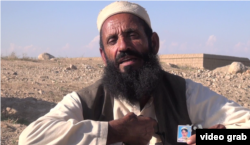Munawwar had not heard from his father for an entire month. Militants claiming to be from the Islamic State group had captured him, along with others from Mamand valley in Achin district of Nangarhar province in Eastern Afghanistan.
Then one day, someone told him about a video circulating on social media that showed IS blowing up people with explosives. He did not dare watch it, so he asked someone to describe it to him. His father was one of the victims.
When IS first started fighting in their region, Munawwar’s father had told him to take the family and go to a safer area.
'What will they do to me?'
"I will stay here and look after the house. What will they do to me? I am an old man. I am innocent," he had said.
So Munawwar left with more than 30 members of his family.
His father told him via telephone that IS had come to their valley, killed everyone in its path, and burned many homes. They had told all old people to gather in the mosque.
Then he heard that IS took all the old men to the mountains and killed some on the way.
One month later, he heard about the video.
'I cannot watch that video'
"I still have not watched that video. I cannot watch that video," he said, trying to hold back his tears.
Munawwar now lives in a building under construction in Jalalabad, the provincial capital of Nangarhar, with his large family, and receives no assistance from anyone. His story is not unique.
Officials say IS has killed or beheaded hundreds of locals in its bid to terrify the population and strengthen its hold on the area. Most of the victims have been members of the Shinwari tribe.
Abdul Malik is one of the tribal elders from Mamand Valley. One day his son came to him and told him to leave the area. IS was capturing and beheading elders.
The young son stayed back to take care of the household. In September, around the Muslim holy festival Eid, lS captured the boy.
"On the fifth day of Eid, someone called and said, 'Your son’s dead body is lying in Shadal Bazaar.' I went to get his body. This is his picture, see!" Malik said, holding up a passport-size picture of his son. IS had put three bullets in his chest. The boy was only 15 years old.
Malik still wonders why IS would kill a poor boy gathering wood in the mountains on his donkey.
Violence is not new to these people. Many areas now under IS control used to be under the control of the Taliban. Locals said, however, that the violence the Taliban perpetrated was not as brutal as the methods used by IS.
Even in other ways, people said, the Taliban in the area were less restrictive.
Zabihullah Zmaray, an elected member of the Nangarhar Provincial Council, elaborated.
"Bati Kot district was under the control of Taliban for a long time," he said. "Still, every year girls graduated high school."
IS harsher than Taliban
When IS militants wrested control of the district from the Taliban, they not only closed the girls’ schools, they also shut down many medical clinics, according to Zmaray.
While IS violence could be random, tribal elders with influence or people associated with the Afghan security forces are particular targets of brutality.
A Shinwari woman from Abdul Khel area, who did not want to reveal her name because she came from a very conservative background, described how IS captured her nephew from a checkpoint and later beheaded him. Her nephew was in the Afghan National Army.
Later, IS demanded money from the family to return the body.
"My husband told them to put the body in a dish and cook it," she said. "They wanted to sell even the dead body. We still don’t have the body back."
Her family later had to pay when IS captured the dead man’s father and threatened to behead him as well. They fled the area, leaving behind a fully furnished house, and are now living in tents in a relatively safer part of Achin. She said they are still scared of the group.













